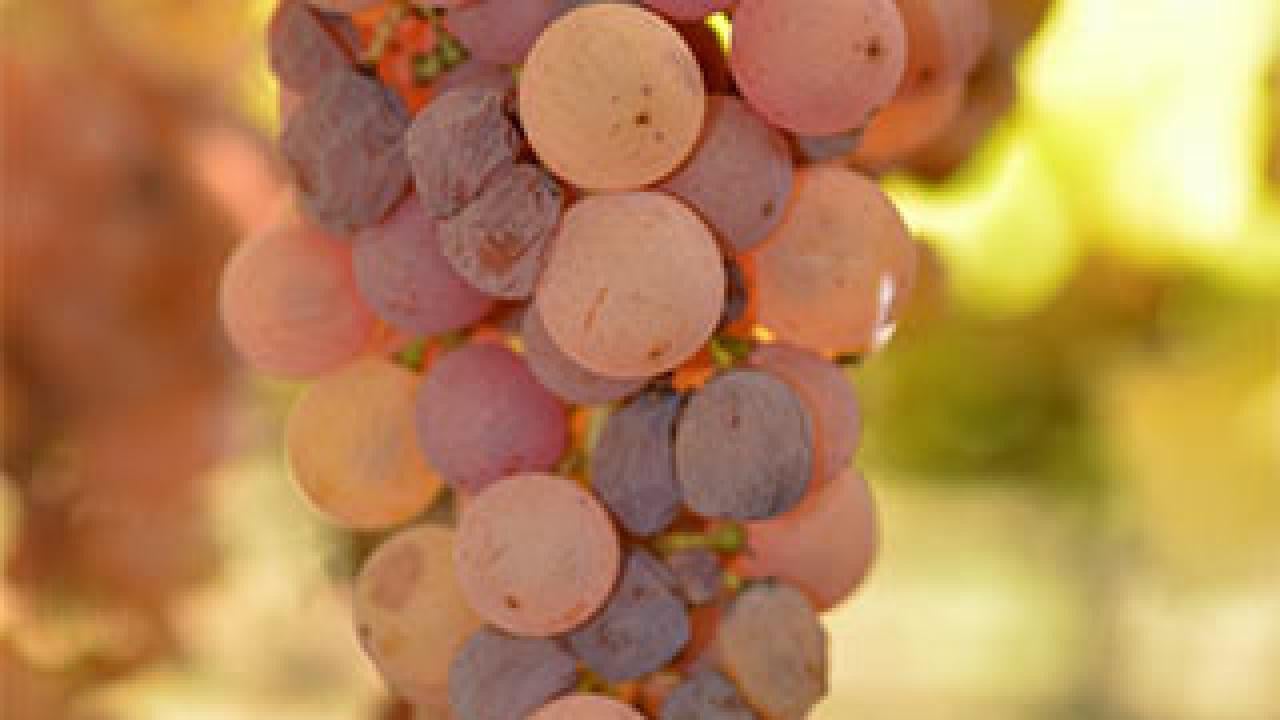For hundreds of years, the fungus Botrytis cinerea has been key to making the world’s finest dessert wines. Now UC Davis researchers working with Dolce Winery in the Napa Valley show how the fungus changes plant metabolism to produce new flavors and aromas in white-skinned grapes.
Under moderately moist conditions, the fungus produces the benign “noble rot,” ideal for making particular high-value dessert wines, known as “botrytized wines” or Sauternes. But when moist conditions prevail in the vineyard, Botrytis spawns noble rot’s evil twin, the so-called “bunch rot.” Bunch rot is a destructive disease that inflicts severe crop losses in all grape-growing regions worldwide.
The UC Davis team found that during noble rot infection, Botrytis induces metabolic processes in white grape berries normally seen only during the ripening of red-skinned grapes. This was a novel observation, because white berries are, in fact, developmental mutants that cannot activate several ripening pathways such as the synthesis of anthocyanins, the molecules that impart the red color in the skin of red grape berries.
The research also confirmed that the reprogramming of grape metabolism by Botrytis results in the accumulation of key aroma and flavor compounds that make sweet wines made from botrytized grapes so special.
Findings from the new study appear this week in the journal Plant Physiology at http://bit.ly/1NJCJxV.
“This study demonstrates how effective it is to integrate genomics and metabolomics in analyzing the impact of plant-microbe interactions on plant metabolism under field conditions,” said plant biologist Dario Cantu of the UC Davis Department of Viticulture and Enology.
The work also may lead to new approaches to improving quality traits in grapes and other fruit, said Cantu, who led the study along with postdoctoral researcher Barbara Blanco-Ulate.
Botrytis has long history in winemaking
Winemakers have made use of the beneficial impacts of Botrytis cinerea — in the form of noble rot — since the 1500s. For example, white-skinned grape berries, naturally infected with noble rot, have been used to produce some of the world’s highest quality dessert wines, referred to as botrytized wines. These wines were first produced in specific regions of Hungary, Germany and France, but now are also made in Italy, Australia, New Zealand, South Africa and California. Botrytized wines are valued for their natural sweetness and distinctive flavor and aroma profiles, which include raisin, pineapple, apricot, pear and honey features.
Systems biology explains how grape berries change during noble rot
In the newly published study, the researchers collected berries of a white-skinned grape variety called Sémillon over three years at the same time the grapes were being harvested for winemaking. They then used state-of-the-art RNA sequencing and metabolomics approaches, as well as enzymatic assays, on those grapes to demonstrate that noble rot:
- induces grape stress responses involved in generating aroma and flavor metabolites; and
- triggers regulators of metabolic pathways that are typically associated with red-skinned grape berry ripening.
The researchers also profiled the metabolites of commercial botrytized wines produced from the same vineyard where the grape berries were collected and verified that key compounds that result from noble rot are carried over to the wines.
Working with Cantu and Blanco-Ulate on this study were professors Susan Ebeler and Hildegarde Heymann, both of the UC Davis Department of Viticulture and Enology; Thomas Collins, currently an assistant professor at Washington State University; Greg Allen, winemaker at Dolce Winery; and Rosa M. Rivero of CEBAS-CSIC research institute in Spain. Other members of the research team were Katherine Amrine, Abraham Morales-Cruz, Carolyn Doyle and Zirou Ye, all of UC Davis; and Ariel Vicente of CONICET, the National Scientific and Technical Research Council of Argentina.
Funding was provided by the UC Davis College of Agricultural and Environmental Sciences, and instrumentation support was provided by Agilent Technologies.
Media Resources
Pat Bailey, Research news (emphasis: agricultural and nutritional sciences, and veterinary medicine), 530-219-9640, pjbailey@ucdavis.edu
Dario Cantu, Viticulture and Enology, 530-752-2929, dacantu@ucdavis.edu
